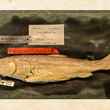Yes, you have to know a few more than seven knots to cover all of fly fishing, but these seven form the core. With them, the fly rodder can fish successfully anywhere. I have used these seven knots since 1955, and have used them for everything from bluegills to tarpon with great success. They are easy to learn, fast to tie, and have excellent strength.
The Clinch Knot
For attaching the fly to the tippet.
The standard Clinch Knot is the one I use most of the time to tie on my fly. It's very fast to tie, and seated correctly, it is quite strong. The only caveat with this knot is to use 5 to 7 turns and pull only the long end when tightening it. Hold the short end, do not pull it!. If you pull the short end, the knot won't turn over correctly, and during casting, or worse yet while fighting a fish, the fly will pop off. This is one the two key reasons (the other being slippage resulting from an improper hook-wire-to-tippet-diameter ratio) why some anglers berate this knot, despite its proven success with countless fish worldwide.
The Improved Clinch Knot
For attaching the fly to the tippet.
The Improved Clinch Knot is a modification that clinches against itself, and will therefore always hold, regardless of hook-wire-to-tippet-diameter ratio.
The Surgeon's Loop
For attaching the backing to the reel.
If you can tie an overhand knot, then you can tie the Surgeon's knots. To attach the backing to the reel, make the loop about 8 inches long. Stick it into the front on the reel, over the top of the spool arbor and back out through the same opening it went into. Put the loop over the reel and draw it tight. When you reel, the loop will lock back against itself. This is a very secure way to attach the backing.
The Surgeon's Knot
For connecting two pieces of leader material.
Here's a very useful tip about tying this knot when it's nearly dark, the mosquitos are biting fiercely and the fish are rising furiously. Instead of making one loop and putting the ends through twice, go around twice to make two loops then put the ends through once. That's right, twice around and once through is the same as once around and twice through. The twice around and once through is easy to do on your fingers even in total darkness.
The Blood Knot
For connecting two pieces of leader material.
The Blood Knot is so called because people sweat blood when learning to tie it. Actually this knot isn't hard to learn, and it's a great connection between pieces of mono. The Blood Knot is thinner in diameter than a Surgeon's Knot and hangs up less in weeds. It can even be used to join materials of dissimilar diameters by employing variations such as the 5/7 Blood Knot.
The (Nailless) Nail Knot
For connecting the backing and the fly line, leader and fly line, two pieces of leader material, for tying a sliding loop on the fly and for attaching the backing to the reel.
The Nailless Nail Knot that I use is a variation of the Uni-Knot or Duncan's Loop Knot. It's used to attach backing to the rear end of the fly line, and the leader or the connector to the front end of the fly line. I've used the Uni-Knot since 1973, but didn't figure out the Nailless Nail Knot variation until 1986. I've used it continuously ever since.
The Perfection Loop
The Perfection Loop is used at the end of the connector, and at the end of the leader to provide a loop-to-loop juncture because the Perfection Loop forms in perfectly direct alignment with the mono. A Surgeon's Loop angles off to the side of the material and can cause the connector-leader juncture to twist.
While the Perfection Loop looks difficult, it is rather easy and very fast to tie. It is just a series of loops. The trick is to get the short end of the material behind the long end when forming the first loop. After that it's just a couple of loops, one wrapped over the other between the first two.






























Comments
rick replied on Permalink
#1) Double Davey
#2) Non-Slip Loop
#3) Japanese Figure 8*
#4) Uni-Knot system
*Replaces the Blood Knot for extremely fast and easy line (tippet) to line (tippet or leader) connection. This knot is a game changer!
Sorry to say but your list was rather disappointing.
DML replied on Permalink
I certainly agree on the Double Davey. On multi-fly rigs, it saves so much time and tippet material.
Anonymous replied on Permalink
Clinch knot. 3-5-7- the thinner the diameter the more wraps you need thick stuff needs less craps
Steven Matthews replied on Permalink
Am I the only one that knots the tag end? No need to trim then and tag end can't slip through. Saved many a battle.
Terry replied on Permalink
My guide in Alaska last year said the perfection loop breaks easily vs the figure 8 loop. Also toss in the Orvis knot, Pitzen knot, Albright knot, and Palomar knot as all are stronger than the Clinch knot.
Mike Lundrigan replied on Permalink
The Davy and the double Davy used to be my go to tippet to fly knots until I discovered the Jack Miller knot! In my experience, it is the best tippet to fly knot ever! You can actually get to the last stage of this knot and choose to make the Miller knot or make the perfection loop just by choosing the final step! This is my variation not the typical version on the internet! If you know how to make a hangman’s noose, do so but with one turn around the line and back thru for the Miller or loop thru loop for the perfection.
Always wet the line tippet before tightening! The Miller knot is a fantastic strong knot and be used for attaching any line around any anchor! It has Never Ever failed me, I make my own leaders and they alway break at another knot, if they break, but never at the Miller!
Such as snagged in a tree! Try it and I doubt you will ever good back! Tying flys for 50+ years! Tight lines!
Pages